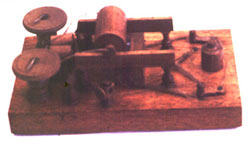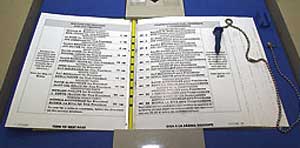Vote Recording Machines
If you remember the controversial 2000 United States presidential election you can surely appreciate the importance of having a reliable and efficient way of counting votes. Although it’s an urgent need now, accurate recording of votes has been a concern long before words such as “chad” and “butterfly ballot” entered the vernacular.
Before 1856 voting in popular elections was done either by oral calls or by writing a vote on a piece of paper. In 1856, the state of Victoria in Australia adopted the first pre-printed paper ballot. This practice quickly spread around the world. But there were many proposals for more efficient and supposedly foolproof automatic voting machines in the 19th century. In fact, an automatic vote recorder was Thomas Edison’s first patented invention. He became interested in voting machines after reading that government officials were considering adopting them. By adapting an earlier technology, the printing telegraph, Edison devised a system designed to record the “yea” or “nay” votes of legislative bodies (e.g., the U.S. Senate). Each voter pressed a lever and had her or his vote recorded on a strip of paper. Unfortunately, nobody seemed interested in using the machine, because politicians used the roll-call vote as an opportunity to state their opinions, and Edison soon moved on to other things.
Machines intended to record or count votes in popular elections were more successful. The first recorded use of a machine to count votes occurred in Lockport, New York in 1892 with the “Myers Automatic Booth.” The machine used levers, each marked with a candidate’s name, and mechanical counters to record the number of times a lever had been pressed. At the end of the voting period, election officials simply read the numbers to tally the votes. While these came to be the most common type of voting technology, they did not allow recounts if there was a contested election.
After the appearance of computers, there was considerable excitement about their potential to count votes. In 1964 two Georgia counties became the first to use the Votomatic, an IBM-designed machine that punched holes in cards to record votes. The cards were then read by a computer to tally the votes. By the 1980s the Votomatic system was the most widely used in the United States. However, there were problems with this technology, because in the case of defectively punched cards it was difficult to interpret the intent of voters. This type of problem was evident in the 2000 U.S. presidential election, when there was considerable debate over the correct interpretation of voter cards in Florida. IBM stopped making Votomatic machines in the 1970s, and in 1988 the U.S. government recommended discontinuing their use.
A proposed solution was optically read ballots. These also used computer-scanned cards or sheets, but used “electronic eyes” to detect marks written or drawn on the sheets. This eliminated the need for the special voting machines required to punch cards in the Votomatic and similar systems, and so eliminated a whole set of potential problems caused by faulty voting machines or their incorrect operation. They also made running elections less expensive.
Today, these machines are also being abandoned in favor of direct-recording electronic vote counters. These are essentially electronic voting machines linked to a computer. Instead of paper ballots, votes are placed by pushing a button or lever. However, it is still necessary to set up temporary polling places during elections, and voters must still travel to those places to vote. Many have suggested that the Internet makes it possible to vote from home. The famous architect and futurist Buckminster Fuller championed a vote-from-home system in the 1960s. He believed voters could simply call in their votes by telephone. They could use their phones to dial in a personal identification number and their votes efficiently and in privacy. However, his ideas were rejected by those who thought that voting in private could make it easier for the dishonest to cast fraudulent votes. Today these same concerns are voiced over Internet voting.

